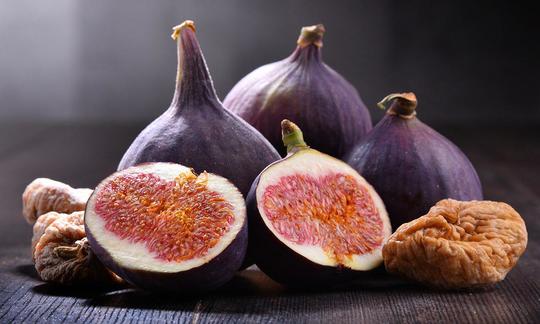Fresh common figs ( Ficus carica ) or edible figs look like teardrops. Depending on the variety, the skin is green-yellow to violet, the flesh is white-pink to reddish with small edible seeds.
Use in the kitchen:
Figs have a sweet, aromatic taste and, when fully ripe, are ideal for desserts, starters and savory dishes.
Use fresh figs immediately after harvesting or buying them, as their shelf life is very limited. Fresh figs taste particularly good in your morning muesli (e.g. pea muesli ). When fully ripe, the common fig makes a great fruit dessert, for example in a fruit salad. The pseudo-fruits can be enjoyed cooked in cakes, tarts, or as compote, fig chutney or mustard.
Figs add an exotic touch to vegetable salads or as a side dish to a main course. Ripe figs are also pressed to make juice, and dessert wine is often made from them. In Spain and Portugal, fig cheese is known, consisting of figs, hazelnuts, pine nuts, almonds, pistachios and spices. Roasted figs can be processed into fig coffee.
Dried figs are also very popular. These and raw figs are suitable for immediate consumption when fully ripe.
| Not only vegans or vegetarians should read this: Vegans often eat unhealthily. Avoidable nutritional mistakes . |
Purchasing:
When purchasing, look for undamaged, nice, plump fruits. Organically produced if possible. Thin-skinned varieties come mainly from Turkey, thick-skinned ones mostly from Greece.
Storage:
Figs have a very short shelf life. Intact fruits only last a few days at room temperature and ripen very quickly. They last a little longer in the fridge, but lose their flavor very quickly.
Ingredients:
Fresh figs contain about 80% water. The mineral content is relatively high in potassium , copper , manganese , magnesium and calcium . Fully ripe figs are also rich in pyridoxine (vitamin B 6 ), thiamine (vitamin B 1 ) and pantothenic acid (vitamin B 5 ).
Health aspects:
As a fresh fruit, the fig with its many small seeds is very rich in fiber, which has a positive effect on digestion and keeps the intestines healthy. The minerals magnesium and potassium contained in it are healthy for the heart. Calcium and potassium protect the bones. The B vitamins contained in figs are good for the nerves and the entire nervous system.
Folk medicine:
In folk medicine, the plant milk that comes out of the broken leaves is used to relieve insect bites and to remove warts. Ficain, the enzyme contained in this milky juice, is also used to determine blood groups and is known as a meat tenderizer. 1
Occurrence:
The cultivation of fig trees is probably older than agriculture. The common fig comes from the Middle East, not from Egypt like other species (ascot fig: Ficus sycomorus ). 2 Remains of a wild form of fig dating back 11,400 years were found in Jericho (west bank of the Jordan). In 5000 BC, the Assyrians also cultivated fig trees in their gardens. From 700 BC, figs were found in Greece and from there the fruit spread throughout the Mediterranean region. The majority of figs are still harvested there today. Smaller harvests come from South Africa, Australia, China, Chile and Mexico. 1
Cultivation, harvest:
Depending on the variety, soil and rainfall, between 80 and 1200 trees are planted per hectare. The summer green, deciduous shrub or tree can reach a height of 3 to 10 m. Hardly any nitrogen fertilizer is used and care is easy. The soil requirements are very low. The common fig can also be found in areas with very little rainfall. The common fig is sensitive to waterlogging. Winters must not be too cold. As soon as the buds are open, the fig tree cannot tolerate bare frosts or late frosts. The common fig tree grows very slowly and begins to bear fruit after seven years. A tree can bear up to 40 kg of fruit and provide this yield for half a century. 2
General information:
The common fig ( Ficus carica var. domestica ) is also called the house fig or edible fig and belongs to the mulberry family (Moraceae). Figs are rarely sold under the variety name, but rather by their origin. The Smyrna variety comes from Turkey, Bari figs from Italy, Fraga figs from Spain, Calamata figs from Greece and Bougie figs from Algeria.
The fig tree is the only representative of the Ficus in Europe. However, there are around 1000 species of the Ficus species worldwide. The mightiest tree in the world, Ficus bengalensis, in Calcutta, has a crown circumference of 300 m. Wild forms of the fig can be found in the eastern Mediterranean as far as the Crimea and Transcaucasia. 2 In addition to the edible fig, which is considered a female fig, there is also the goat fig, capri fig, wood fig or goat fig ( Ficus carica var. caprificus ), which contains sterile female "gall flowers". These fruits are usually very woody, hard, dry and often inedible. The goat fig is functionally considered a male plant. It is also called a capri fig. There are a few varieties with edible fruits (e.g. the White Marseille variety). 3
An alternative name for the common fig ( Ficus carica var. domestica ) is the term edible fig. In subtropical or tropical areas with summer rain, figs cannot be dried and are therefore only eaten as fruit or preserved. The reason: they burst too often and then spoil within hours due to acid formation by bacteria or yeast. 4
There are more than 100 varieties of edible figs. The pollinating gall wasps develop in the short-stalked female flowers of wood figs, which means they are loaded with pollen. 4
With the right climate and weather, edible figs and wood figs can produce three generations of fruit: spring figs, summer figs and autumn figs. Spring figs are the tastiest, but summer figs produce the largest quantities. Adriatic figs are suitable for planting in home gardens because they ripen parthenocarpically, meaning they do not require pollination. 4
In literature, the fig tree has been mentioned in a positive way in various countries and religions for thousands of years. In Greece, Rome, but also in the Bible and Christianity, the fig and the fig tree are associated with fertility. In India, it is considered sacred. It is mentioned as a symbol of peace and prosperity. On the other hand, there are also negative uses of the fig: connections with suicide, torture, war or as a swear word. 1
Common German names are Feygen, Fichboum, Ficheffele, Figa, Fig, Figenbaum, Figenbaym, Figenom, Figenboum, Figenpawm, Fygen, Smakka, Smakkabagms, Veigenpoum, Veyg, Vichboum, Vick, Vyck, Vig, Vige, Vigbom, Vigenbom, Vigboum, Vighen, Vyghen, Wighen and Wyk. 1
Literature / Sources:
- German Wikipedia Common fig.
- Brücher H. Tropical crops. Origin, evolution and domestication. Springer-Verlag: Berlin Heidelberg New York; 1977.
- Seiler C. Figs from your own garden. Stuttgart 2016. 93-94.
- Rehm / Espig; The cultivated plants of the tropics and subtropics; ut 1976.











Comments